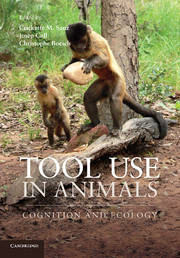Book contents
- Frontmatter
- Contents
- List of contributors
- Part I Cognition of tool use
- Part II Comparative cognition
- 4 Insight, imagination and invention: Tool understanding in a non-tool-using corvid
- 5 Why is tool use rare in animals?
- 6 Understanding differences in the way human and non-human primates represent tools: The role of teleological-intentional information
- 7 Why do woodpecker finches use tools?
- Part III Ecology and culture
- Part IV Archaeological perspectives
- Index
- References
6 - Understanding differences in the way human and non-human primates represent tools: The role of teleological-intentional information
from Part II - Comparative cognition
Published online by Cambridge University Press: 05 March 2013
- Frontmatter
- Contents
- List of contributors
- Part I Cognition of tool use
- Part II Comparative cognition
- 4 Insight, imagination and invention: Tool understanding in a non-tool-using corvid
- 5 Why is tool use rare in animals?
- 6 Understanding differences in the way human and non-human primates represent tools: The role of teleological-intentional information
- 7 Why do woodpecker finches use tools?
- Part III Ecology and culture
- Part IV Archaeological perspectives
- Index
- References
Summary
Introduction: redefining man or redefining tools?
On a morning in 1960, Jane Goodall made an observation that would forever change the way scientists think of our own species’ place in the animal kingdom: she observed a non-human animal fashioning and using a tool. There, for the first time, Goodall witnessed the famous Gombe chimpanzee David Greybeard fishing for termites. She watched as, over and over, he grabbed a twig, stripped off its leaves, placed it inside a termite mound, and then retracted it to lick off a pile of termites. Even on that morning, Goodall recognized the significance of her observation (Goodall, 1986). At the time, scientists had assumed that humans were the only species capable of a cognitive feat like Greybeard’s termite fishing. Indeed, sophisticated tool use had long been heralded as one of the key differences between humans and other animals. With a single observation, Goodall had challenged this understanding of non-human cognition. She excitedly detailed her findings in a telegram to her mentor, the anthropologist Louis Leakey, who replied with his now famous rejoinder: “Now we must redefine ‘man,’ redefine ‘tool,’ or accept chimpanzees as humans.”
In the five decades that have followed Goodall’s original observation, scientists are still struggling with the particulars of Leakey’s interpretational challenge. On the one hand, researchers have learned much more about the impressive nature of non-human tool use, thereby redefining what it means to be a tool-using creature. We now know, of course, that humans and chimpanzees are not alone in their use and design of tools. Since Goodall’s original observations, scientists have documented cases of tool use in nearly every taxa of the animal kingdom (see reviews in Beck, 1980; Hauser, 2000). We’ve observed capuchins using hammers (Ottoni & Izar, 2008; Chapter 10), orangutans using spears (van Schaik et al., 2003), cephalopods using costumes (Finn et al., 2009) and crows making fishing hooks (Weir et al., 2002; see also Chapter 5). Indeed, non-human tool use is now known to be both varied – involving a variety of different kinds and combinations of tools – and flexible – with many species employing tools to solve an array of different kinds of problems.
- Type
- Chapter
- Information
- Tool Use in AnimalsCognition and Ecology, pp. 119 - 133Publisher: Cambridge University PressPrint publication year: 2013
References
- 17
- Cited by

